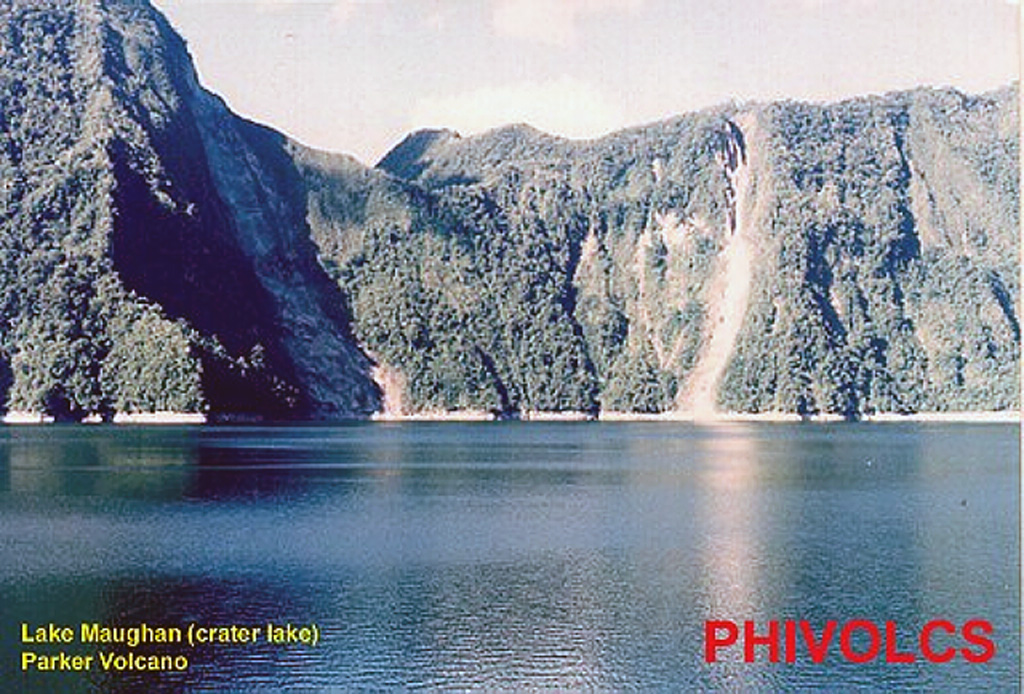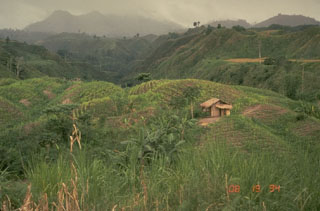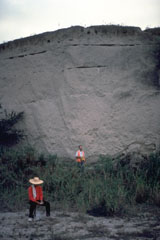

PHIVOLCS staff dispelled concerns that Parker might erupt after a M 7.5 earthquake (according to the US Geological Survey NEIC) occurred near the volcano on 6 March at 0516. According to news articles, tremor caused a portion of the volcano's crater wall to breach and fall into Lake Maughan atop the volcano. Articles also stated that tons of water that were released from the lake washed away houses and about 33 families were evacuated from river banks below Lake Maughan due to fears that more of the lake would overflow. Government agencies plan to conduct an aerial inspection to assess the lake's water level.
Sources: Reuters, US Geological Survey Earthquake Hazards Program, Agence France-Presse (AFP), Philstar News
Crater lake overflow causes flooding; no volcanic activity
The overflow of Maughan Lake, the crater lake at Parker volcano, followed heavy rains associated with a passing typhoon and caused flashflooding in NW-flank communities on 6 September. A team from the Philippine Institute of Volcanology and Seismology (PHIVOLCS) was dispatched to determine whether the overflow was caused by volcanic activity. Although no volcanic alert was declared, PHIVOLCS recommended that the crater area should be considered off-limits because of instability of the crater walls. Fieldwork on 8-9 September revealed that the flood was channel-confined along the NW-flank Alah River, which drains the crater lake, from 1,000 m down to 540 m elevation (Barangay New Dumangas, T'boli, South Cotabato Province). Below this point it was transformed into a sheetwash. The floods killed more than 60 people, destroyed 300 homes and nine bridges, and displaced 50,000 people.
Aerial observations on 11 September indicated that two or three landslides, indicated by escarpments, had occurred along the Alah River prior to the crater lake outbreak. The total mass displaced appears to have been sufficient to have dammed the upper reaches of the river. The crater wall was well-vegetated and without landslide scars, although underwater landslides may have contributed to the rise and subsequent overflow of the lake. The overflow breached the blocked river channel, sending an estimated ~10-15 x 106 m3 of lake water down the river, lowering the lake by 1 m. No turbidity or color change was observed in the crater lake, indicating that there had been no volcanic explosion. On 9-10 September PHIVOLCS installed seismometers in T'boli, 12 km NW of the crater at 540 m elevation, and at Tobolok, ~4 km NW of the crater at 1,300 m elevation. No volcanic seismic events were recorded through 11 September.
Information Contacts: Ernesto G. Corpuz, Philippine Institute of Volcanology and Seismology (PHIVOLCS), 5th & 6th Floors Hizon Building, 29 Quezon Avenue, Quezon City, Philippines; United Press International.
2002: March
PHIVOLCS staff dispelled concerns that Parker might erupt after a M 7.5 earthquake (according to the US Geological Survey NEIC) occurred near the volcano on 6 March at 0516. According to news articles, tremor caused a portion of the volcano's crater wall to breach and fall into Lake Maughan atop the volcano. Articles also stated that tons of water that were released from the lake washed away houses and about 33 families were evacuated from river banks below Lake Maughan due to fears that more of the lake would overflow. Government agencies plan to conduct an aerial inspection to assess the lake's water level.
Sources: Reuters; US Geological Survey Earthquake Hazards Program; Agence France-Presse (AFP); Philstar News
Reports are organized chronologically and indexed below by Month/Year (Publication Volume:Number), and include a one-line summary. Click on the index link or scroll down to read the reports.
Crater lake overflow causes flooding; no volcanic activity
The overflow of Maughan Lake, the crater lake at Parker volcano, followed heavy rains associated with a passing typhoon and caused flashflooding in NW-flank communities on 6 September. A team from the Philippine Institute of Volcanology and Seismology (PHIVOLCS) was dispatched to determine whether the overflow was caused by volcanic activity. Although no volcanic alert was declared, PHIVOLCS recommended that the crater area should be considered off-limits because of instability of the crater walls. Fieldwork on 8-9 September revealed that the flood was channel-confined along the NW-flank Alah River, which drains the crater lake, from 1,000 m down to 540 m elevation (Barangay New Dumangas, T'boli, South Cotabato Province). Below this point it was transformed into a sheetwash. The floods killed more than 60 people, destroyed 300 homes and nine bridges, and displaced 50,000 people.
Aerial observations on 11 September indicated that two or three landslides, indicated by escarpments, had occurred along the Alah River prior to the crater lake outbreak. The total mass displaced appears to have been sufficient to have dammed the upper reaches of the river. The crater wall was well-vegetated and without landslide scars, although underwater landslides may have contributed to the rise and subsequent overflow of the lake. The overflow breached the blocked river channel, sending an estimated ~10-15 x 106 m3 of lake water down the river, lowering the lake by 1 m. No turbidity or color change was observed in the crater lake, indicating that there had been no volcanic explosion. On 9-10 September PHIVOLCS installed seismometers in T'boli, 12 km NW of the crater at 540 m elevation, and at Tobolok, ~4 km NW of the crater at 1,300 m elevation. No volcanic seismic events were recorded through 11 September.
Information Contacts: Ernesto G. Corpuz, Philippine Institute of Volcanology and Seismology (PHIVOLCS), 5th & 6th Floors Hizon Building, 29 Quezon Avenue, Quezon City, Philippines; United Press International.
This compilation of synonyms and subsidiary features may not be comprehensive. Features are organized into four major categories: Cones, Craters, Domes, and Thermal Features. Synonyms of features appear indented below the primary name. In some cases additional feature type, elevation, or location details are provided.
Synonyms |
| Falen | Maughan, Lake | Parker |
|
|
||||||||||||||||||||||||||
There is data available for 3 confirmed Holocene eruptive periods.
1640 Dec 26 ± 5 days - 1641 Jan 4 Confirmed Eruption VEI: 5 (?)
| Episode 1 | Eruption | |||||||||||||||||||||||||||||||||||||||||||||||||||||||||||||||||||||||||||||||||||||
|---|---|---|---|---|---|---|---|---|---|---|---|---|---|---|---|---|---|---|---|---|---|---|---|---|---|---|---|---|---|---|---|---|---|---|---|---|---|---|---|---|---|---|---|---|---|---|---|---|---|---|---|---|---|---|---|---|---|---|---|---|---|---|---|---|---|---|---|---|---|---|---|---|---|---|---|---|---|---|---|---|---|---|---|---|---|
| 1640 Dec 26 ± 5 days - 1641 Jan 4 | Evidence from Observations: Reported | ||||||||||||||||||||||||||||||||||||||||||||||||||||||||||||||||||||||||||||||||||||
|
List of 15 Events for Episode 1
| |||||||||||||||||||||||||||||||||||||||||||||||||||||||||||||||||||||||||||||||||||||
1380 ± 75 years Confirmed Eruption VEI: 4
| Episode 1 | Eruption | ||||||||||||||||||||||||||||||||||||||||
|---|---|---|---|---|---|---|---|---|---|---|---|---|---|---|---|---|---|---|---|---|---|---|---|---|---|---|---|---|---|---|---|---|---|---|---|---|---|---|---|---|
| 1380 ± 75 years - Unknown | Evidence from Isotopic: 14C (calibrated) | |||||||||||||||||||||||||||||||||||||||
|
List of 6 Events for Episode 1
| ||||||||||||||||||||||||||||||||||||||||
1920 BCE ± 40 years Confirmed Eruption VEI: 4
| Episode 1 | Eruption | ||||||||||||||||||||||||||||||||||||||||
|---|---|---|---|---|---|---|---|---|---|---|---|---|---|---|---|---|---|---|---|---|---|---|---|---|---|---|---|---|---|---|---|---|---|---|---|---|---|---|---|---|
| 1920 BCE ± 40 years - Unknown | Evidence from Isotopic: 14C (uncalibrated) | |||||||||||||||||||||||||||||||||||||||
|
List of 6 Events for Episode 1
| ||||||||||||||||||||||||||||||||||||||||
There is no Deformation History data available for Mélébingóy.
There is no Emissions History data available for Mélébingóy.
 Parker volcano, seen here from the E, is located at the S end of Mindanao Island in the Philippines. Reconnaissance studies of the volcano revealed resemblances to Pinatubo volcano, which also produced thick of pyroclastic flow deposits around its flanks. Parker is now thought to be the source of a major eruption in 1641 that plunged much of Mindanao into darkness.
Parker volcano, seen here from the E, is located at the S end of Mindanao Island in the Philippines. Reconnaissance studies of the volcano revealed resemblances to Pinatubo volcano, which also produced thick of pyroclastic flow deposits around its flanks. Parker is now thought to be the source of a major eruption in 1641 that plunged much of Mindanao into darkness.  Geologists investigate a thick pyroclastic flow deposit on the ENE side of Parker volcano in southern Mindanao. Preliminary investigation of the eruptive deposits of this volcano revealed many similarities to those of Pinatubo. The flanks of both volcanoes are blanketed with thick pyroclastic flow deposits produced by powerful explosive eruptions.
Geologists investigate a thick pyroclastic flow deposit on the ENE side of Parker volcano in southern Mindanao. Preliminary investigation of the eruptive deposits of this volcano revealed many similarities to those of Pinatubo. The flanks of both volcanoes are blanketed with thick pyroclastic flow deposits produced by powerful explosive eruptions. Lake Maughan occupies the steep-sided walls of the 2.9-km-wide Parker summit caldera of , also known locally as Falen. This vegetated edifice overlooks Sarangani Bay near the southern tip of Mindanao Island and is surrounded by extensive, young pyroclastic flow deposits. This volcano was the source of a major explosive eruption in 1641.
Lake Maughan occupies the steep-sided walls of the 2.9-km-wide Parker summit caldera of , also known locally as Falen. This vegetated edifice overlooks Sarangani Bay near the southern tip of Mindanao Island and is surrounded by extensive, young pyroclastic flow deposits. This volcano was the source of a major explosive eruption in 1641.Maps are not currently available due to technical issues.
There are no samples for Mélébingóy in the Smithsonian's NMNH Department of Mineral Sciences Rock and Ore collection.
| Copernicus Browser | The Copernicus Browser replaced the Sentinel Hub Playground browser in 2023, to provide access to Earth observation archives from the Copernicus Data Space Ecosystem, the main distribution platform for data from the EU Copernicus missions. |
| MIROVA | Middle InfraRed Observation of Volcanic Activity (MIROVA) is a near real time volcanic hot-spot detection system based on the analysis of MODIS (Moderate Resolution Imaging Spectroradiometer) data. In particular, MIROVA uses the Middle InfraRed Radiation (MIR), measured over target volcanoes, in order to detect, locate and measure the heat radiation sourced from volcanic activity. |
| MODVOLC Thermal Alerts | Using infrared satellite Moderate Resolution Imaging Spectroradiometer (MODIS) data, scientists at the Hawai'i Institute of Geophysics and Planetology, University of Hawai'i, developed an automated system called MODVOLC to map thermal hot-spots in near real time. For each MODIS image, the algorithm automatically scans each 1 km pixel within it to check for high-temperature hot-spots. When one is found the date, time, location, and intensity are recorded. MODIS looks at every square km of the Earth every 48 hours, once during the day and once during the night, and the presence of two MODIS sensors in space allows at least four hot-spot observations every two days. Each day updated global maps are compiled to display the locations of all hot spots detected in the previous 24 hours. There is a drop-down list with volcano names which allow users to 'zoom-in' and examine the distribution of hot-spots at a variety of spatial scales. |
|
WOVOdat
Single Volcano View Temporal Evolution of Unrest Side by Side Volcanoes |
WOVOdat is a database of volcanic unrest; instrumentally and visually recorded changes in seismicity, ground deformation, gas emission, and other parameters from their normal baselines. It is sponsored by the World Organization of Volcano Observatories (WOVO) and presently hosted at the Earth Observatory of Singapore.
GVMID Data on Volcano Monitoring Infrastructure The Global Volcano Monitoring Infrastructure Database GVMID, is aimed at documenting and improving capabilities of volcano monitoring from the ground and space. GVMID should provide a snapshot and baseline view of the techniques and instrumentation that are in place at various volcanoes, which can be use by volcano observatories as reference to setup new monitoring system or improving networks at a specific volcano. These data will allow identification of what monitoring gaps exist, which can be then targeted by remote sensing infrastructure and future instrument deployments. |
| Volcanic Hazard Maps | The IAVCEI Commission on Volcanic Hazards and Risk has a Volcanic Hazard Maps database designed to serve as a resource for hazard mappers (or other interested parties) to explore how common issues in hazard map development have been addressed at different volcanoes, in different countries, for different hazards, and for different intended audiences. In addition to the comprehensive, searchable Volcanic Hazard Maps Database, this website contains information about diversity of volcanic hazard maps, illustrated using examples from the database. This site is for educational purposes related to volcanic hazard maps. Hazard maps found on this website should not be used for emergency purposes. For the most recent, official hazard map for a particular volcano, please seek out the proper institutional authorities on the matter. |
| IRIS seismic stations/networks | Incorporated Research Institutions for Seismology (IRIS) Data Services map showing the location of seismic stations from all available networks (permanent or temporary) within a radius of 0.18° (about 20 km at mid-latitudes) from the given location of Mélébingóy. Users can customize a variety of filters and options in the left panel. Note that if there are no stations are known the map will default to show the entire world with a "No data matched request" error notice. |
| UNAVCO GPS/GNSS stations | Geodetic Data Services map from UNAVCO showing the location of GPS/GNSS stations from all available networks (permanent or temporary) within a radius of 20 km from the given location of Mélébingóy. Users can customize the data search based on station or network names, location, and time window. Requires Adobe Flash Player. |
| DECADE Data | The DECADE portal, still in the developmental stage, serves as an example of the proposed interoperability between The Smithsonian Institution's Global Volcanism Program, the Mapping Gas Emissions (MaGa) Database, and the EarthChem Geochemical Portal. The Deep Earth Carbon Degassing (DECADE) initiative seeks to use new and established technologies to determine accurate global fluxes of volcanic CO2 to the atmosphere, but installing CO2 monitoring networks on 20 of the world's 150 most actively degassing volcanoes. The group uses related laboratory-based studies (direct gas sampling and analysis, melt inclusions) to provide new data for direct degassing of deep earth carbon to the atmosphere. |
| Large Eruptions of Mélébingóy | Information about large Quaternary eruptions (VEI >= 4) is cataloged in the Large Magnitude Explosive Volcanic Eruptions (LaMEVE) database of the Volcano Global Risk Identification and Analysis Project (VOGRIPA). |
| EarthChem | EarthChem develops and maintains databases, software, and services that support the preservation, discovery, access and analysis of geochemical data, and facilitate their integration with the broad array of other available earth science parameters. EarthChem is operated by a joint team of disciplinary scientists, data scientists, data managers and information technology developers who are part of the NSF-funded data facility Integrated Earth Data Applications (IEDA). IEDA is a collaborative effort of EarthChem and the Marine Geoscience Data System (MGDS). |